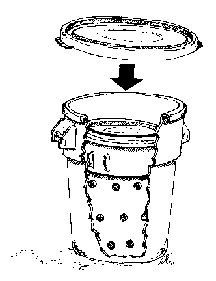Stealth Composting
This is a technique for composting discreetly, in a garbage can or similar container. For those who want to compost but are constrained by limited space, or hypercritical neighbors, or are discouraged at the prospect of crossing a snowy yard to the compost bin, this may be the perfect technique! The bin can be beside your back door, in a garage, or even in your kitchen! Here’s what you need:
- One large plastic container and a smaller one that fits inside it (matched garbage cans work well)
- A method of punching holes in the bottom of the smaller container
- A place to put the larger container in
- Woodchips
- Sawdust (you can mix in some shredded paper)
- Food scraps!
How does it work?
 Here’s
what it looks like, in a cut-away side view: The inside container holds your
food scraps. Each layer of food scraps should be covered well with sawdust. As
this material starts to break down it will warm up – this is a sign that the
decomposers are at work!
Here’s
what it looks like, in a cut-away side view: The inside container holds your
food scraps. Each layer of food scraps should be covered well with sawdust. As
this material starts to break down it will warm up – this is a sign that the
decomposers are at work!
Warm air rises, and fresh air will get drawn in from the bottom. The coarse
layer of woodchips in the outside container allows air to pass through the holes
in the inside container and up through the layer of woodchips in the bottom
there. Fresh air is important, because a lack of oxygen will favor the
“anaerobic” decomposers (who thrive in the absence of oxygen). These organisms
help break down the food scraps, but they give off bad odors. In contrast the
“aerobic” organ-isms (who require oxygen) do all their work without creating
smells. Indoors or outdoors, the key to non-smelly com-post is to allow oxygen
to move through the pile!
When the container is full, move it to a spot out of the way to let the
breakdown continue. You may have to add water if the contents dry out – the
decomposer organisms need a moist environment. As they do their work you will
see the volume go down by a third to a half. If conditions are right, it will
take two to three months for the compost to finish the active phase. At that
point it should be allowed to sit, preferably outdoors somewhere, with exposure
to air and rain, for the compost to “cure” properly. (If you want to free up the
two-can system sooner you can move the compost to an outside bin or pile after
several weeks and let composting continue there.)
Popular Composting Articles
Composting |
Composting Bins | Vermicomposting |
Composting with Worms |
Homemade Compost Problems
Popular Composting Products
Composting |
Compost Accessories |
Compost Pails |
Compost Systems |
Worm Bins
-


Think Four Seasons: When designing your backyard landscape, remember that there are four seasons. You will want flowers and shrubs which bloom during different times of the season, autumn foliage during the fall, and a structure that can withstand the winter.


-


Plan before you dig a water garden. Before you even start to think of digging to put in a water garden, make sure you plan everything in advance. Dimensions, the type of water garden you want to have, how deep it will need to be and if you need any permits to do so. If in doubt, call a professional out to help you. That's why they are there.


-


Get the right supplies for the job. Make sure you always get the exact right supplies you need for the job at hand. Don't skimp on quality when you are landscaping your backyard as you will pay dearly for it in the long run.

